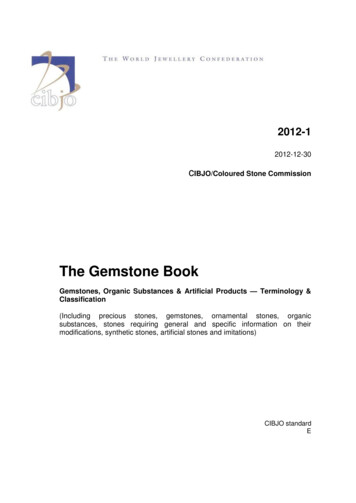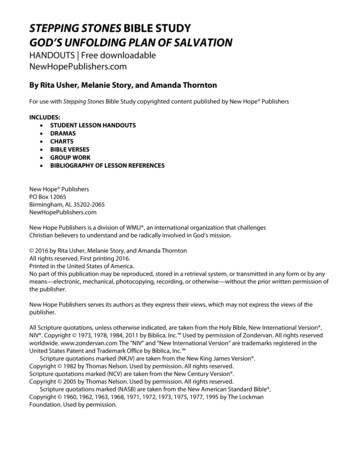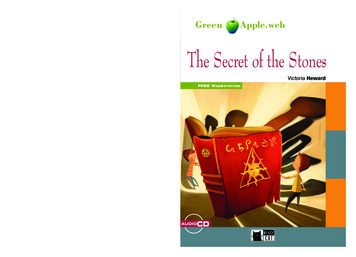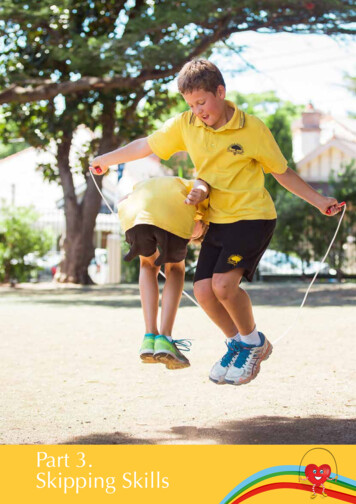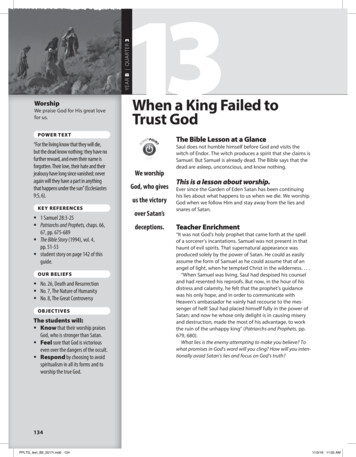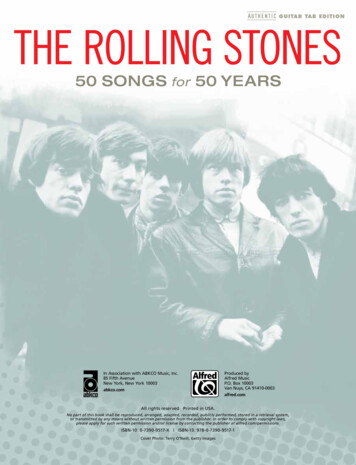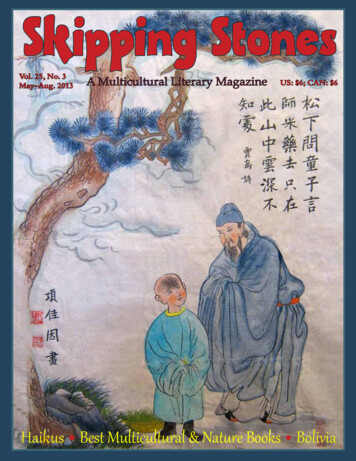
Transcription
Skipping StonesVol. 25, No. 3May–Aug. 2013A Multicultural Literary MagazineUS: 6; CAN: 6Haikus Best Multicultural & Nature Books Bolivia
The 2013 Skipping Stones Honor AwardsIn the year of our 25th Anniversary, we recognize 25 outstanding books and teachingresources with the Skipping Stones Honor Awards. The honored books promote anunderstanding of cultures, cultivate cooperation and encourage a deeper understanding of the world’s diversity. They also encourage ecological richness, respect for multiple viewpoints and close relationships within human societies. These great readingadventures offer a variety of learning experiences for readers of all ages.The winners are listed in three categories—Multicultural and InternationalBooks, Nature and Ecology Books, and Teaching Resources. Our specialthanks go to the many readers and reviewers who helped us select these 22 books and 3DVDs. We believe these unique titles offer an exciting way to explore and understand cultures, places, societies and their histories. The reviews of winning titles follow:Multicultural and International BooksDidn’t We Have Fun!By Hilda Robinson& Jeff Kunkel, illustr. Hilda Robinson(Cr ickhollowBooks.com). Picture book.Elementar y g rades.ISBN: 978-1-93398717-0In Didn’t We Have Fun, Hilda Robinson goesback to her roots, detailing life in a world before television. The narrator shares what it was like being raised inan African-American family with six siblings in 1940’sPhiladelphia.Children spent their time learning to play instruments, reading poetry, playing outside, listening tothe radio for entertainment, and studying. Travellingthrough time, Robinson notes the role of significanthistorical figures in daily life such as poet Paul LaurenceDunbar and boxing champion Joe Louis, as well aspopular movies such as “Sleeping Beauty” and “ShirleyTemple.”From holidays to cuddling with her mother, toschool, playground games, and family picnics, the storyis filled with an appreciation for the simple things inlife and joys of being raised in a tight-knit family. Thisbook is a light-hearted and insightful read about thevalue of spending quality time with family in AfricanAmerican culture.—Kamiiya Williams, African American, Univ. of Oregon.Page 2Tea Cakes for Tosh by KellyStarling Lyons, illustr. E. B.Lewis (penguin.com/youngreaders). Elementary grades.Picture book. ISBN: 978-0399-25213-6This heart-tugging booktells the story of a young boynamed Tosh who loves tospend time with his grandmother, Honey. Each timeTosh visits, he looks forward to having another servingof Honey’s delicious tea cakes, which smell like “vanillamixed with sunshine” and provide a taste that “warmshis heart.” Along with her delightful treats, Honeynever forgets to tell Tosh the story of how she becameacquainted with their remarkable taste.Ida, Honey’s grandmother, worked on a slave plantation as a cook. A talented baker, Ida’s tea cakes wereregarded as “the best around.” However, as a slave, shecould never share any of her famous dishes with herchildren and was only permitted to cook for her master’s family. Occasionally, Ida would slip a few tea cakesin her pocket and sneak them to the small outhousewhere she and her children lived. Their young faces“beamed with hope,” as Honey recalls it. Honey tellsthis story to Tosh each time.As the story progresses, Honey’s age takes a toll onher memory. She begins to forget many things suchas where she parked her car and her sister’s phonenumber. More importantly to Tosh, she forgets how toSkipping Stones Book AwardsMay 2013
Multicultural and International Booksmake tea cakes! Disturbed by his grandmother’s loss ofmemory, Tosh decides to do something special. Withthe help of his mother, he makes a batch of tea cakes,using the same ingredients and following the same stepsjust as he has seen his grandmother do many times. Thenext day, he surprises Honey with his own plate of teacakes and reminds her of how the tasty cookies cameto be.This book nicely illustrates how history is passeddown from one generation to the next in AfricanAmerican culture. Like many children, Tosh learns toassociate a specific food with storytelling, and by theend of the story, readers can see how the two intimatelyrelate. As Grandma Honey’s memory fades away, thestories of the plantation and Grandma Ida’s tea cakesare preserved through Tosh, who will likely share thesame stories with his children. Tea Cakes for Tosh is agreat read for any child, as it colorfully celebrates therelationship between family, food, and stories.—Kamiiya Williams, African American, Univ. of Oregon.Unspoken: A Story from the Underground Railroadby Henry Cole (scholastic.com). Picture book withoutwords. Elementary grades. ISBN: 978-0-545-39997-5On the back cover of this book is a drawing of agirl’s face. She is looking straight ahead with a seriousexpression. She is holding up a lantern. There is a question written on the drawing: “What would you do ifyou had the chance to help a person find freedom?”That question is the only writing found in the book,except for a wanted poster and the Author’s Notes atthe very end.This is a story told with drawings, and it is welltold. The main character is young girl who lives withher family on a farm during the Civil War. As she goesaround the farm feeding the chickens, gathering andstoring vegetables, andcaring for the animals,she witnesses historicalevents, such as soldiersriding across her family’s land and bountyhunters looking forslaves. One day shesenses the presenceMay 2013of a person hiding in an outbuilding on the farm. Sherealizes the person is a slave, running for his life inhopes of freedom.The girl decides to help the runaway, and herfamily looks the other way. The silence of the storyreminds me of the Quakers, a religious group whohave always tried to help those in trouble. Many of thehouses on the Underground Railroad, where runawayslaves found refuge, belonged to Quakers. They helpedthousands of slaves escape, moving in secret from onesafe house to another until they reached the North andfreedom.The silence encourages the reader to delve deeper,to notice emotions on faces and meanings behindactions. The last drawing, showing the girl gazing outher bedroom window at the Big Dipper, brought tearsto my eyes. To so many frightened people, those starsmeant hope and freedom.—Mary Meredith Drew, writer and educator, OregonQ u e e n o f t h e Tr a c kby Heather Lang, illustr.Floyd Cooper (boydsmillspress.com). Picture book.Elementary grades.ISBN:978-1-59078-850-9Queen of the Tracktells the inspiring story ofAlice Coachman, the firstAfrican-American womanto win an Olympic goldmedal. While most girls of her time weresettled on washing clothes and cooking, Coachmanloved to run, jump, and “play with the boys.”Born and raised in segregated rural Georgia,where there were no gyms, parks, or tracks availableto African-Americans, Coachman ran barefoot ondirt roads and tied together sticks with rags to makeher own high jumps. The talented novice wasn’t overlooked, and in the seventh grade, she was given theopportunity to run for the well-regarded TuskegeeInstitute, an all-black school known for its academicand athletic programs.Coachman finished high school at Tuskegee whereSkipping Stones Book AwardsPage 3
Multicultural and International Booksshe was able to compete in track and field and basketball against athletes of her own age as well as collegestudents. By the time she graduated, she made her markas the best high-jumper in the country and one of thefastest runners.Soon after that, the talented young star set her eyeson the world stage of athletics. After years of training, Coachman qualified to high-jump in the 1948Olympics held in England and walked away with ashiny gold medal and record breaking performance.This story is a definite must-read as it reinforces thepower of human resilience, hard work, and big dreams.—Kamiiya Williams, African American, Univ. of Oregon.The Lynching of Louie Samby Elizabeth Stewart (annickpress.com). Novel. Middle andUpper grades. ISBN: 978-155451-438-0A narrative of one of themost disturbing injustices inthe days of American westwardexpansion, author ElizabethStewart provides The Lynchingof Louie Sam, a powerful storyof racial conflict, greed, and the struggle for righteousness. Based on true events that tookplace in 1884 in the newly settled Washington Territory,the story unfolds as fifteen-year-old George Gillies andhis siblings discover the corpse of a local settler andsoon realize that he has been murdered. What ensues isa tragic tale of injustice as George follows the vengefultownspeople in pursuit of a suspicious-looking NativeAmerican, Louie Sam, all the way across the border toCanada where the angry mob lynches Sam in revenge.Young, innocent, and free from the racial prejudices that the majority of the settlers possess, Georgeis the first to formulate doubts about the actions of thetownspeople, especially after witnessing the face of theaccused murder: a fourteen-year-old boy. Could theyoung Louie Sam be the murderer, or were the mobleaders wrong? Perhaps an even more shocking question, did the men purposely frame an innocent NativeAmerican child? As George attempts to uncover thetruth, he must come to terms with his own actions andPage 4pursue the moral high ground against the unfettereddenial and opposition of his fellow settlers.The Lynching of Louie Sam is a powerfully writtennarrative: gripping, fluidly presented, and thought-provoking throughout. The story is a poignant recount ofone of the major historical injustices in American history, as well as a window into the thoughts and viewsof a period marked by the hardships of expansion andsevere racial strife. Stewart’s novel is a brilliantly told,strikingly realistic piece of America’s conflicted past.—Julian Mullins, student intern, grade 11, Oregon.The Poet Upstairs by JudithOrtiz Cofer, illustr. Oscar Ortiz(artepublicopress.com). Picturebook. Elementary grades.ISBN: 978-1-55885-704-9Juliana is home sick, missing her first day of school.Looking out her apar tment window, she sees a tallwoman wearing a red sweater and hat, carrying boxes ofbooks into the building.“I hear she is a famous poet, that she lived on anisland just like me,” Mami tells her. Juliana is thrilledthat a poet will be living upstairs, and Juliana can hearher moving around and even typing on her typewriter.Slipping in and out of vibrant dreams of islandsand rivers while a cold snow falls outside her window,Juliana is comforted and inspired by the sounds of thetypewriter upstairs. When she wakes up, she draws pictures of what she imagines the poems might say. Sheslides a drawing under the poet’s door.The poet invites Juliana upstairs, and they writea poem together, a poem that comes alive to Julianaas they work. Her world melts into the world of thepoem, with rivers, mountains, palm trees, seagulls, parrots and nightingales. Flowers are everywhere, and thesun is bright and warm. Soon the poet says the poem isfinished, and they return to the world of the apartment,where it is still snowing, and Juliana sees only tall buildings all around.The poet tells Juliana that she can write her ownSkipping Stones Book AwardsMay 2013
Multicultural and International Bookspoems now. She needs only to believe that words canchange the world. The poet has brought richness andpossibility into Juliana’s world, and now she can write apoem whenever she wishes to inhabit her dreams.Magical, muted yet colorful illustrations evoke thedreamlike quality of this lovely story. The author inviteseveryone into the world of poetry and helps us believethat words can change the world.—Mary Meredith Drew, writer and educator, OregonLos pájaros no tienen fronteras: Leyendas y mitos de AméricaLatina by Edna Iturralde, illustr.Andrezzinho (librosalfaguarainfantil.com/co). In Spanish only.Grades 6-9. ISBN: 978-958-758494-3Ecuadoran author, EdnaIturralde, has masterfully taken40 legends and myths from20 Latin American countriesand presented them to us in a new light full of mischief, humor and wisdom. While some of us may havealready heard some of these folktales, such as the wellknown story of La Llorona from Mexico, the way theyare re-written may make us feel like we are readingthem for the first time. Also included are lesser-knownbut equally touching tales.The short and entertaining stories offer us aglimpse of the rich oral traditions of each country.They take us on a journey through historical times andhelp us feel connected with our past and our brothersand sisters all over the American continent.This book is suitable for middle school childrenwith advanced Spanish skills. It is also appropriate fornative speakers of Spanish at all grade levels. I recommended it highly.—Esther Celis, our board member, Oregon.Finders Keepers? A True Story in India and itsSpanish translation, ¿Es Mio? Una historia verdaderaen la India by Robert Arnett, illustr. Smita Turakhia(www.AtmanPress.com). Picture books. Grades 1-6.ISBN: 978-0-96529008-1 and 978-0-96529000-5Finders Keepers? A True Story in India is a colorMay 2013ful and exciting bookbased on a youngman’s travels throughRajasthan, India.With detailed illustrations and valuablelessons in honestyand freedom, thisbook has something for all ages.The story is set in a little red bus piled high withluggage and crammed with people from all over. It isbursting with festivity. The bus takes the passengerson a tour of Rajasthan, a trip that is bound to be evenmore sensational than anticipated. The readers discoverIndian cultural tidbits such as the nuns of the Jain temple, the Hindu religion, Indian foods like naan, Indianmilkshakes and chutney, and some extravagant customsand delicacies along the way. Characters learn valuablelessons in honesty, courage and doing what’s right.Overall, this book is a great pick. It combines factand recollection to communicate information andexperiences in a friendly and exciting way. The explosive illustrations will spark the imagination of youngerpeople, while the facts, tidbits, and multicultural references will interest older readers. This book is enjoyableand interesting. I would recommend it for children agesseven and up.—Jane Brinkley, age 11, student, Oregon.NOTE: ¿Es Mio? Una historia verdadera en laIndia is a Spanish version of Finders Keepers? andprovides an additional intercultural aspect to it especially for Spanish language learners and speakers.Three Year s andEight Months by IcySmith, illustr. JenniferKindert (eastwestdiscovery.com). Picturebook. Elem. andmiddle grades. ISBN:978-0-98562378-4.T h r e e Ye a r sand Eight Months takes us back to HongKong in 1941. From the eyes of a 10-year-old ChineseAmerican boy, we witness the horrors faced by millionsSkipping Stones Book AwardsPage 5
Multicultural and International Booksof Hong Kong natives when the Japanese army invadedtheir city. Villages were burned down, families tornapart, and everyone who wasn’t a Japanese soldier wastreated like a slave. For three years and eight months,Japanese soldiers walked the streets of Hong Kong,changing lives for generations to come.Early on in the story, the main character—Choi—befriends a kind-hearted Japanese soldier namedWantabe-san. Wantabe-san gives Choi and his uncleextra food in exchange for firewood. After a year inHong Kong, the Japanese stop giving food rations, andpeople are living off of tree bark and various plants.Choi, his uncle, and his friend are kept alive by thekindness of one soldier who helps them. Choi alsolearns some Japanese with the help of Wantabe-san andis eventually able to work at a Japanese military station.Here, he observes the inner-workings of the Japanesearmy and uses his findings this to his advantage.Upon his uncle’s request, Choi and his friend beginstealing medicine and first-aid supplies to help thewounded. Their bravery saves millions of lives.This book is a well written, easy-to-understandaccount of historical events. Keeping a light and factualtone, the author paints a picture of what life was likefor Choi. With beautiful illustrations throughout, ThreeYears and Eight Months is hard to put down. The reader will constantly want to know what happens next.—Amanda Johnson, student intern, OregonThe Whole Story of Half of a Girl by VeeraH i r a n a n d a n i (randomhouse.com/kids).Novel.Middle grades. ISBN: 978-0-38574128-6Sonia, a fifth grader in a private school, is biracial. Herfather, a Hindu, is a transplantfrom India, and mom is JewishAmerican. They both work andthe family has a typical Americanlife on the East Coast. But whenher dad loses his job as the headof sales of a college textbookcompany, Sonia finds herself treading unfamiliar watersof public school without friends, and her family lifechanges drastically.Page 6Sonia wants to make new friends and belong to the‘cool’ group of girls. Kate, one of her new classmates,asks Sonia to be a cheerleader, but Sonia must satisfyherself only as an ‘Alternate’ or, as she thinks of it, ‘Halfa cheerleader.’Readers will enjoy this easy-to-read multiculturalnovel. While it does not start out as a ‘different’ story,there are enough twists in the plot to make it enjoyable. We get introduced to both the Jewish and Indiancultures, and when Sonia’s father has a serious episodeof depression, the story takes another turn. You’ll haveto read the book to find out how Sonia deals with thischallenge in her life.—Arun Naraayan Toké, editor.Hope and Tears: EllisIsland Voices by GwenythSwain (calkinscreekbooks.com). History. Grades 5-10.ISBN: 978-1-59078-765-6Hope and Tears is a moving historical depiction ofthe many people who camethrough Ellis Island at atime when it was the largestimmigration station in theUnited States.Through a combination of text and photos, Gwenyth Swain successfully portrays the excitement, fear, and hope that was felt by nearly twelvemillion immigrants who passed through this island ontheir journey to American citizenship. A unique mixture of historical backgrounds as well as immigrants’personal accounts, poems, and letters to loved onescomes together to form a picture of what it may havebeen like for people who experienced Ellis Island.The chapters of the book have titles such as“Arrivals,” “Inspections,” and “Living and Working,”which highlight the different aspects of what it waslike to arrive in the United States in the late 1800’sand early 1900’s. Included are the stories of immigrantssuch as Annie Moore, a 15-year-old Irish immigrantwho was the first person to pass through Ellis Island;Margaret, an English immigrant who writes of thecrude and frightening tools used by the health inspectors; and Hubert Julian, a black immigrant detaineeSkipping Stones Book AwardsMay 2013
Multicultural and International Bookswho waits anxiously for his fate to be determined as hetries to enter a “white” country.Swain creates a very powerful compilation of experiences that, as she explains in the introduction, maybe read silently to oneself or performed out loud like aplay. The stories and photos vary greatly; they are sometimes cheerful and sometimes sad, but always touching.This book is sure to enlighten readers.—Maureen Phenix, student, University of Oregon.Peace by Wendy AndersonHalperin (drawingchildrenintopeace.com). Picture book. Allages. ISBN: 978-0-689-82552-1This is a gorgeous bookdedicated to one thing: “peace.”It should be read and the ideaspracticed by all of human kind.The book begins with what isneeded for world peace andcontinues on to inspire peacein each individual heart. After peace is firmly embedded in each heart it spreads to homes, schools, neighborhoods, cities, nations, until you have peace in theworld. Peace comes around full circle.Each page is covered with different sized andshaped windows of peace. Each window is colored inpastel colors with its own shape and picture of peace.Some windows display human interactions, whichdemand patience and forgiveness before peace cancome inside. In between these windows are quotesconcerning peace from famous people such as Plato,Desmond Tutu, Gandhi, Roberto Clemente, Lao Tzu,Mother Teresa, Dr Martin Luther King, Jr. and others.With so many beautiful thoughts to live by it is difficultto choose one favorite saying, but this one from JeremyAldana stands out: “It’s not so much the journey that’simportant, as is the way that we treat those we encounter and those around us, along the way.”—Paulette Ansari, President of the Board and AfricanAmerican storyteller, Oregon.People Who Said No: Courage Against Oppressionby Laura Scandiffio (annickpress.com). Grades 6-11.ISBN: 978-1-55451-382-6.May 2013Presented here is the story ofseven courageous people whotook a stand and did the rightthing. It is also the story of theirfamily members, friends, andneighbors who supported themin some cases even until death.The first story is titled, “TheWhite Rose” and refers to themessage that Sophie Scholl, herbrother, and their friends spread against Hitler andNazi Germany. They took a brave stance writing anddistributing secret phamplets against Nazism.The next story is about Rosa Parks and how shehad the courage to remain seated on the bus when shewas ordered to give her seat to a white passenger. Herstory goes on to tell how many people stood behindthe bus boycott, which eventually ended segregation inpublic places across the United States.Next we read Andrei Sakharov’s story. He was oneof the scientists who invented the Soviet nuclear bomb.He soon realized the problems of pursuing nuclearweapons and dedicated the rest of his life to civil rightsand world peace.The other people included in this book are HelenSuzman, who defied Apartheid in South Africa; OscarRomero, the Archbishop of San Salvador who supported the poor peasants; Aung San Suu Kyi and herstruggles to get fair elections in Burma; and the peopleat large fighting for their civil rights in Egypt. Eachstory is well-written, in-depth and inspiring.—Paulette Ansari, Oregon.Outcasts United: The Story of a Refugee SoccerTeam that Changed a Town by Warren St. John (randomhouse.com/kids). Grades 6-9.ISBN: 9780-385-741941Outcasts United is an excellent book about the differenceone person can make in a community. Clarkston, Georgia wasa rather typical Southern townuntil it was designated a refugeesettlement center in the 1990s. Itthen became the first AmericanSkipping Stones Book AwardsPage 7
Multicultural and International Bookshome for multitudes of families fleeing war zones aorund the world from countries like Liberia and Sudanto Iraq and Afghanistan. Suddenly Clarkston’s streetswere filled with women wearing the hijab, the smellsof cumin and curry, and kids of all colors playing soccer in any open space they could find. Luma Mufleh,an American-educated Jordanian woman, also finds herway to this town, and settles down to organize a youthsoccer team to unify Clarkston’s refugee children andkeep them off the streets. These kids named themselvesthe Fugees.The book follows an important season in the livesof the Fugees and their coach, Luma. As a very diversegroup of individuals, they slowly grow close, forming abond through their shared interest: soccer. Luma is thecenter of it all, bringing the outcasts together and driving them to success. Throughout the novel, Clarkstonevolves from a small rural town to a global community,and the characters radiate strength and the determination it takes to succeed in a world where you’re theodd one out.Well-written and fast-paced, this book is a fun read.It is uplifting and enlightening, as well as entertaining,especially for soccer lovers everywhere.—Hanna Hostick, student intern, OregonThat Mad Game: Growing Up in a War Zone by J.L. Powers (www.cincopuntos.com). Ages 13 to adults.ISBN: 978-1-935955-22-1Most North Americans live in an insulated world(unless, of course, they live in an inner-city neighborhood with lots of gun violence, poverty, or crime).They have not really experienced war. Their knowledge and experiences are limited to two-hour warmovies or video games, and when they walk out ofmovie theaters or video arcades, their life is back tobusiness as usual.Seventeen writers from around the world—maleand female—share experiences of the many faces ofwar in this outstanding book. Each of these first-handaccounts touched my heart. As I moved from onechapter to another, I was transported to different countries and continents—from Afghanistan to Vietnam,from Bosnia to South Africa, Mexico to China.Page 8To read these essays aboutlife in the midst of war, as seenthrough the eyes of youth affected by war, you might like to takesome time for reflection afterreading each chapter and thusdigest the depth of feelings thateach writing evokes. It is not abook that you want to finish inone sitting or one evening. Each writer sharestheir heart and soul as they tell us what war meant tothem and how their lives were transformed as a result.Many of the memories shared are from the narrators’ childhood or formative years. We learn of themodern history of the world, but it is through the lensof young people’s eyewitness accounts. Each chapterhas a background introduction so readers can connectthe dots. We learn about the genocides in Cambodiaand Rwanda, cultural revolution in China, overthrowof the Shah in Iran, and the internment of JapaneseAmericans in the western states during the SecondWorld War.While most pieces share the heartache and atrocities, there are many parts where the beauty of thehuman spirit shines through. Jerry Mathes, whosefather was a Vietnam veteran, writes about how thewar affected his father and the family. From humor inQais Omar’s “A Talib in Love” in Kabul to determination in Fito Avitia’s “From Fear to Hope” in CiudadJuarez, Mexico, to David Griffith’s “Symphony No. 1,”each essay is a worthy creation that opens up mindsand hearts. That Mad Game is a compelling read formature, upper graders (grades 9 to 12) and adults.—Arun Naraayan Toké, editor.Papers: Stories of Undocumented Youth edited by JoseManuel, et al., illustr. Julio Salgado (papersthemovie.com). Grades 7-11. ISBN: 978-0-9857485-0-0“Whether America wanted us or not, we becameher children.”Many children and young people living in theUnited States do not feel wanted by this country. Theylive in fear of being sent away, back to a country theydo not know. They might not even know the languagespoken in that country.Skipping Stones Book AwardsMay 2013
There are at least two million young people currently inthe United States who do nothave legal documentation or permission to be here. They werebrought into the country bytheir parents, and their status asresidents is in limbo. They live inthe shadows, unable to be fullythemselves because they cannot tellanyone they are here without permission. But whenthe time comes to get a driver’s license, go to college orget a job, they find out it is impossible for them to livethe way their “legal” friends and neighbors do.Hopefully conditions will change for these youthas the government rethinks its immigration laws.President Obama and others want to change the lawsso that the young people brought to the United Statesby their parents are able to earn their citizenship.In the meantime, many are experiencing the hardships of living here without documents. Some of theirstories have been collected by teachers and friends forthis book.One girl, Eva, says, “When I hear people say ’illegal alien,’ I feel like they are referring to me as if Iwas from another planet, as if I wasn’t from the sameearth.”A boy named Eric talks about going to a schoolwhere everyone made fun of him because he was different. He grew up angry, depressed, and with low selfesteem. But he says he will never give up because thereare people and things he cares about.The authors of these essays come from many places.They are black, white, and brown. As Eric says, they arehumans, just trying to live their lives and provide fortheir families.I am equally as inspired by the strength of theseyoung people as I am angered by the way they aretreated and the terrible situation they are living in, byno fault of their own. Through reading this book, youwill gain a deeper understanding of their experiences.Hopefully, you will be able to encourage other peopleto be more tolerant of the undocumented humanbeings who live among us, and maybe you will want toMay 2013Nature and Ecology Bookshelp in the struggle for better immigration laws in theUnited States.—Mary Meredith Drew, writer and educator, OregonPotatoes on Rooftops:Farming in the City by HadleyD ye r ( a n n i c k p re s s . c o m ) .Elementary and middle grades.ISBN: 978-1-55451-424-3This informative book isoverflowing with inspiringinformation about urban gardening. Its wealth of creativeideas and engaging photos emphasize that anyonecan garden no matter how much space they have, andDyer proposes easy steps to get the urban gardenerstarted. By covering a wide range of topics, this bookexamines the many issues cities face in supplying theirinhabitants with food. It raises awareness of problemslike the lack of availability of fresh foods in low-incomeurban neighborhoods, how far food travels before it’sserved to your table, and that not all people are guaranteed good food to eat. In doing so, Dyer challengesreaders to reevaluate their relationship to their foodand to take control of this relationship by growing theirown.This book, in showing how to take your foodinterests into your own hands, stresses how urban gardening can help alleviate problems such as those mentioned above. Urban gardens of all sizes can provide asignificant amount of fresh food, which is especiallyimportant for regions deemed “food deserts” or placeswhere fresh produce is scarcely sold. This allows theurban gardener to add much needed vegetables to theirdiet that were otherwise difficult to obtain and providesa reliable sourc
Page 2 Skipping Stones Book Awards May 2013 The 2013 Skipping Stones Honor Awards Didn’t We Have Fun! By Hilda Robinson & Jeff Kunkel, illus-tr. Hilda Robinson (CrickhollowBooks. com). Picture book. Elementary grades. ISBN: 978-1-933987-17-0 In Didn’t We Have Fun, Hilda Robinson goes ba
